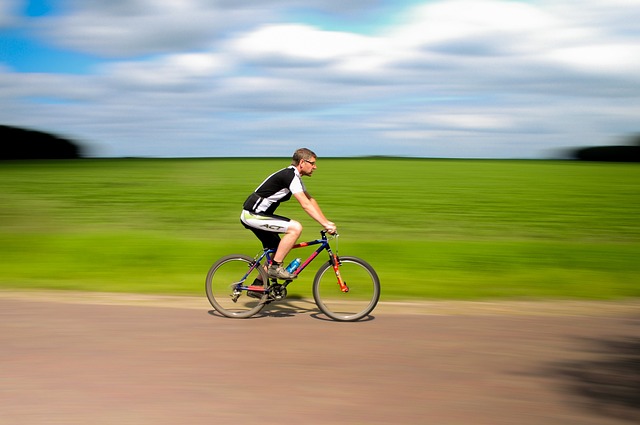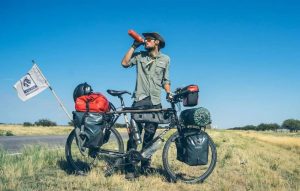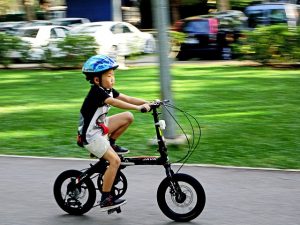sYou can see yourself there, hurtling downhill at a high rate of speed. When you look down at your bike computer while hunched over the bars and grip the drops with white knuckles, you can see the speedometer’s needle click up to 70 km/h. Oh yes, you are now flying. But before you can pick up speed, a junction is indicated by a road sign, so you hit the brakes to safely come to a stop.
What if that junction didn’t exist, though? What if the slope was as long, smooth, and steep as you could possibly desire? What if there were no obstacles, bends, or stray dogs in the road?
How fast could you go on a bike? By examining what’s preventing you from moving forward, let’s start to address that question.
Table of Contents
How Fast Can You Ride a Bike?
The typical, untrained person can pedal a bike at a speed of 10 to 14 miles per hour (MPH). This person’s speed can increase to 15 to 20 MPH after a few weeks of training. After a few months of rigorous conditioning, he can reach speeds of up to 30 or even 25 MPH.
Your ability to pedal a bike at its top speed may be impacted by a number of factors. Later, we will talk in greater detail about what you can do to address these issues.
How Fast Can Professional Cyclists Go?
Professional cyclists can ride their bikes at a top speed of 45 mph while facing the wind and using nothing but pure power to move forward.
With a top speed of 82.82 MPH on unpaced bikes, or bicycles that are powered only by the legs, Todd Reichert holds the world record.
Cycling competitors are a unique breed. A professional cyclist competing in the Tour de France, for instance, travels at an average speed of about 25 MPH while completing sprints, flat sections, and hill climbs.
The average speed on the French flats for a well-trained TdF cyclist is 26 to 29 MPH, but they can reach speeds of up to 34.5 MPH.
Cycling enthusiasts will slow down to about 12 MPH, with a 14 MPH peak, as they climb the Pyrenees during the Tour de France.
However, during sprints during the Tour de France, cyclists have broken the 40-MPH barrier.
Professional cyclists who race indoors or in speed arenas are quicker than those who race outside.
Cycling can reach speeds of 60 to 70 MPH thanks to the velodrome’s distinctive design, shape, and 42-degree bankings. Cycling enthusiasts have the advantage of pushing themselves and their bikes to the limit because there are no winds or other hazards to worry about.
The fastest bicycle speed, however, was recorded in September 2016 by Denise Mueller-Korenek, a US national track champion and then-45-year-old American who also competed in road and mountain biking. Her time was 183.932 MPH.
Of course, one could argue that the world record-breaking achievement is not possible without the mechanical assistance of a dragster and without taking advantage of the race car’s slipstream before pedaling to fame.
It is still an amazing feat because the speed is comparable to a Boeing 747 jumbo jet just before takeoff.
Factors That Affect Bike Speed
Weight
We’re not just referring to your weight; we’re also referring to the weight of your bicycle. Individual weight is determined by gravity. You are heavier when there is a stronger gravitational force pulling on you and opposing you as you move forward.
You may have noticed that due to the added weight of backrests, water bottles, and luggage racks, professional road cyclists avoid using them. Lightweight bikes are an option if you so choose.
Tires and Wheels
You travel more quickly the larger the tire. When you ride a bike quickly, there is more air resistance pushing back against your bike, slowing you down. A larger tire, however, has an advantage over a smaller tire in cutting through wind resistance. Because of the advantage it has over a smaller tire, high-end racing bicycles typically have larger tires mounted on their wheels than standard road bikes.
Depending on the surface they are mounted on and the inflation pressure, various tire types have different behaviors. For instance, a tire with a low profile has a better ability to grip the ground, making it better suited to rough or uneven terrain and less suited to smooth or flat terrain.
Regarding the wheel’s speed, the same principle holds true. You move more quickly the larger and faster the wheel. Professional bicycles have extremely light wheels, whereas standard bicycles typically have medium-sized wheels.
Gearing Systems
Choosing a fast bike involves taking into account gearing systems like internal and easy gears. By automatically shifting gears, these gearing systems enable you to pedal at higher speeds without exerting much effort, so you don’t have to. High-end racing bicycles typically have internal gears, while older conventional bikes typically only have two or three external gears.
Suspension Systems
Bump impact is absorbed and reduced in intensity by suspension systems’ soft suspension cams, which act as a spring. Due to the lighter load on your muscles, you can move more quickly. In other words, your muscles don’t have to work as hard because the impact’s force is lessened.
Along with road bikes, expensive racing bicycles feature suspension systems. Typically, suspension systems are not used on road bikes; instead, they are only used by professional road cyclists who want to increase their speed.
Strength
Leg and thigh muscular strength are two of the key factors affecting cycling speed. The stronger you are, the faster you pedal. As cycling becomes a routine part of your life, you gradually exert less energy for the same amount of work.
Endurance has an impact on cycling speed as well. Your leg and thigh muscles need oxygen, fatty acids, and glucose to produce the energy required for cycling. Your muscles will use other energy sources if they run out of oxygen.
Therefore, increasing your stamina is essential if you want to increase the oxygen-carrying capacity of your lungs.
Resistance
Drag, resistance, and friction can all cause you to slow down.
On a bicycle, you can’t go as fast as you want because of resistance factors like air pressure and wind speed.
Regarding your biking stance, it’s also crucial. To lower their body profile and achieve a more streamlined form, competitive cyclists stoop low on their bicycles. They are seated so that air can pass over their curved bodies rather than slamming them in the chest.
The choice of clothing and a helmet is also essential. Despite the fact that wearing a loose or baggy outfit may be more comfortable, the extra fabric can make you slower and cause resistance.

How to Improve Your Biking Speed?
Don’t Be Overweight
To move more quickly, you’ll need to either build strength or reduce your weight. It all comes down to your power-to-weight ratio, or how many watts you can produce per pound of body weight, when cycling, especially when climbing hills. Each pound you lose will increase your average speed, assuming that your bike, equipment, power, and fitness stay the same.
Improve the Aerodynamics
You can improve your aerodynamics and expose less of your body to the wind by performing the following instead of riding with your hands on the tops or hoods of your handlebars:
- Bending your elbows will help you to slouch and achieve a flat back.
- Riding in the hoods is a term used to describe the act of riding in the hoods
- Place your elbows so that they are directly in front of your knees.
- Lower your forehead.
Watch Your Lactate Threshold.
If you raise your lactate threshold, you’ll be able to pedal more forcefully for longer periods of time while maintaining the same heart rate. This will make you faster overall. Continue to be energetic.
Ride With Trained Cyclist
Your average speed will increase significantly if you ride a few times a week with a trained cyclist or a friend who is faster than you, but it will also help you if you decide to ride alone. A great training partner will motivate you to ride farther and faster than you otherwise would. You’ll advance more quickly the more you push yourself to leave your comfort zone. However, avoid overusing your muscles because doing so can be dangerous. Give yourself some grace.
Handle Your Bike Properly
You can’t move quickly if you’re constantly slamming on the brakes to slow down. And, believe it or not, this has nothing to do with blatant disregard for the safety of oncoming traffic, including failure to stop at stop signs or red lights. If you enhance your bike handling, which involves applying the brakes as little as possible, you’ll be able to descend more quickly and make sharp turns at higher speeds.
You’ll be able to ride closer to other cyclists and shield yourself from the wind while doing so by honing your handlebar skills.
No matter if you ride an electric bike or a mountain bike, you should follow these steps whether you are a pro or a beginner. After taking these actions, monitor your progress and contrast your previous speed with your current speed to observe the difference.
Unpaced Biking Records
The International Human Powered Vehicle Association (HPVA) is an organization that keeps track of, examines, and logs unpaced bike records. As a result, the cyclist is exposed to the wind and is not being supported by a motor.
Sam Whittingham is the first to break the record. Sam, a cyclist from Canada, is the holder of several HPVA records. At 82.82 mph, he set the record for fastest time.
Todd Reichert, whose top speed was measured at 89.85 mph, is the current record holder.
Motor Paced Records
However, a few people have surpassed this average. For instance, John Howard was the first person to surpass 152 MPH. He had the strength, speed, and agility necessary to achieve such a high speed because he was an Olympic cyclist and triathlete.
Since then, cyclists have planned to attempt to surpass his record. Fred Rompelberg wasn’t able to surpass this until 1995, when he reached a speed of 166.9 mph.
He was able to set this record by mounting his bike to the back of a Strasburg Drag Racing Team dragster. As a result, he was able to break the previous record and raise the bar for motor-paced cycling in the future.
Read about How Fast Do Electric Bikes Go?
FAQs
How Fast Does a Normal Person Bike?
The average speed of a road bike when riding on roads with a flatter elevation profile is between 14 and 18 mph (23-29 km/h). Alternatively, most road cyclists can anticipate an average cycling speed of between 8 and 12 mph (13-19 km/h) when riding on inclines of 5%.
Is 20 Mph Fast on a Bike?
20 mph is an average speed for a bike, but if you’re in a flat, paved area with no obstacles, then it’s probably not too difficult to maintain. This speed might be too fast for them to handle if you are not skilled or if you are riding with a novice.
Is 30 Mph on a Bike Fast?
30mph is a fast speed for a bike. It is challenging to accomplish on a flat surface, but it can be done with a good hill on a road. The Strava speed graphs from two of my rides—one on my mountain bike and one on a commuter path—are shown below.
What is the Maximum Speed We Can Ride in Cycle?
Cycling speed records
The highest speed officially recorded for a bicycle ridden in a conventional upright position under fully faired conditions was 82 km/h (51 mph) over 200 m.
Can You Outrun a Bear on a Bike?
Considering that a black bear can sprint more than 30 mph, cyclists should remember that you can’t outrun a bear on a bike unless you have a very long head start, an unencumbered racing bike, and the abilities of a time trial champion.
Conclusion
How quickly can you ride a bicycle? The average person can pedal their bicycle at a respectable 10 to 14 miles per hour. You can push yourself to cycle up to 30 MPH with the right training, the right weight, and resistance-reduction techniques.
Of course, there’s always a chance to shoot for the best honor any cyclist could ever receive: breaking the motor-paced bike’s 183.932-MPH world record.



